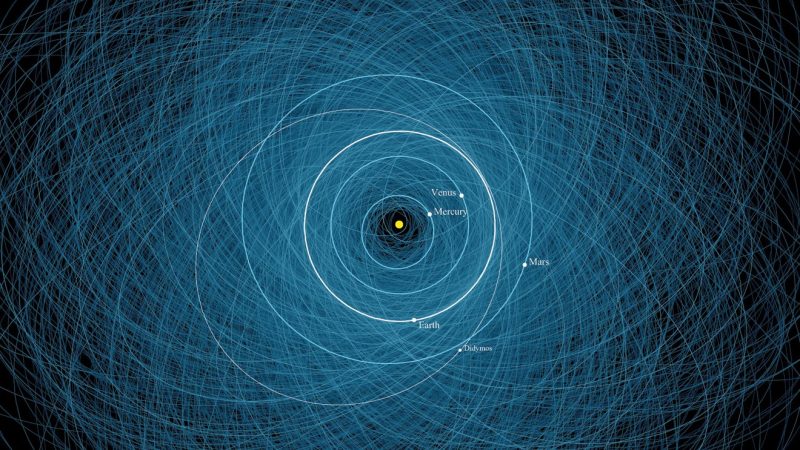
NASA said this week (December 6, 2021) that its newest asteroid monitoring system, an algorithm called Sentry-II, has gone live. It’s now assessing the impact risk of asteroids that pass near Earth. Telescopes surveying the sky have found approximately 28,000 near-Earth asteroids, aka NEAs. With more advanced telescopes coming online, NASA expects scientists to discover many more near-Earth asteroids. So – in keeping with a growing realization over the past several decades (“wow, there are a lot of asteroids out there, and one might strike us!”) – these scientists have now realized they need an improved system to evaluate impact probabilities.
The peer-reviewed Astronomical Journal published a study describing the new technique on Dec. 1, 2021. The paper is available on arXiv.
The original Sentry
Calculating the path of asteroids and how they might impact with the Earth in the future is a challenging activity. Small uncertainties in the asteroids’ positions create big question marks. The Center for Near Earth Object Studies (CNEOS) uses impact monitoring software to calculate the risk. The group, part of NASA’s Jet Propulsion Laboratory, has used software called Sentry to compute the orbit and impact risk of asteroids since 2002.
Javier Roa Vicens, formerly of JPL and currently at SpaceX, said:
The first version of Sentry was a very capable system that was in operation for almost 20 years. It was based on some very smart mathematics: In under an hour, you could reliably get the impact probability for a newly discovered asteroid over the next 100 years – an incredible feat.

EarthSky 2022 lunar calendars now available! They make great gifts. Order now. Going fast!
The new-and-improved Sentry-II
Sentry-II is an upgrade because it can quickly calculate impact probabilities for all known NEAs. That includes some special cases that the original Sentry could not compute. Sentry-II logs the riskiest objects in the CNEOS Sentry Table.
Sentry-II’s new capabilities allows NASA to assess all potential impacts, even when the asteroids’ odds of impact are as low as a few chances in 10 million.
Special case: The Yarkovsky effect
The path of asteroids is not as simple as merely bending to the will of the sun’s gravity. Another force, though small, can create significant changes in the object’s orbit. As asteroids rotate in space, the sun heats the side facing the asteroid. As it spins away, the hot side cools. When the asteroid cools down, it release a minute amount of energy. This thermal force is the Yarkovsky effect.

The original Sentry was not able to calculate the Yarkovsky effect. In the short term, the Yarkovsky effect isn’t crucial, but after decades and centuries those small pushes from the sun’s heat add up. Davide Farnocchia of JPL said:
The fact that Sentry couldn’t automatically handle the Yarkovsky effect was a limitation. Every time we came across a special case – like asteroids Apophis, Bennu, or 1950 DA – we had to do complex and time-consuming manual analyses. With Sentry-II, we don’t have to do that anymore.
Special case: Close encounters with Earth
Another shortfall the original Sentry had was that it couldn’t always adjust for an asteroid’s altered path after an extreme close encounter with Earth. When an NEA comes too close to Earth, our gravity will deflect it from its original path. Sentry-II can account for tweaked orbits after an asteroid passes close to Earth. Roa Vicens explained:
In terms of numbers, the special cases we’d find were a very tiny fraction of all the NEAs that we’d calculate impact probabilities for. But we are going to discover many more of these special cases when NASA’s planned NEO Surveyor mission and the Vera C. Rubin Observatory in Chile go online, so we need to be prepared.
Asteroid impact monitoring and calculations
Determining whether an asteroid might impact Earth is a multi-step process. First, the telescopes discover a new NEA. Then, scientists measure the position of the NEA and report this information to the Minor Planet Center. Next, CNEOS uses the data to calculate the asteroid’s most likely orbit. With slight uncertainties in the observed position, the asteroid’s most likely orbit might not be its true orbit. The true orbit lies within a realm of uncertainty, like a cloud of possibilities around the calculated most likely orbit.
To narrow down the true orbit, the original Sentry made assumptions regarding how this cloud of uncertainty would evolve. Sentry then picked evenly spaced points along a line spanning this region. Each point marked a slightly different location where the asteroid might be.
Next, Sentry would project the orbits forward in time, watching the virtual asteroids orbit to see if any would come near Earth. For those that did, Sentry made further calculations to “zoom in” and see if any points might impact Earth. If any did intersect with Earth, Sentry estimated the probability of impact. The animation below provides a visualization of this process.
Asteroid impact monitoring with Sentry-II
Sentry-II doesn’t limit itself to a line of points. The new algorithm models thousands of points without making any assumptions. It selects random points across the entire cloud of uncertainty. The algorithm looks at all the possible orbits to determine which ones could hit Earth. Sentry-II takes out some of the guesswork. It also zeroes in on low probability impact scenarios that Sentry may have missed.
Farnocchia describes it as searching for needles in a haystack. The haystack represents the cloud of uncertainty, with needles representing possible impacts. While Sentry would look for needles in a line in the haystack, Sentry-II throws thousands of magnets at random throughout the haystack. Steve Chesley of JPL said:
Sentry-II is a fantastic advancement in finding tiny impact probabilities for a huge range of scenarios. When the consequences of a future asteroid impact are so big, it pays to find even the smallest impact risk hiding in the data.

Bottom line: The asteroid impact monitoring system Sentry-II is analyzing near-Earth asteroids to look for ones that could intersect with Earth’s orbit.
Source: A Novel Approach to Asteroid Impact Monitoring
The post Asteroid impact monitoring system goes live first appeared on EarthSky.
from EarthSky https://ift.tt/3pz6K9T

NASA said this week (December 6, 2021) that its newest asteroid monitoring system, an algorithm called Sentry-II, has gone live. It’s now assessing the impact risk of asteroids that pass near Earth. Telescopes surveying the sky have found approximately 28,000 near-Earth asteroids, aka NEAs. With more advanced telescopes coming online, NASA expects scientists to discover many more near-Earth asteroids. So – in keeping with a growing realization over the past several decades (“wow, there are a lot of asteroids out there, and one might strike us!”) – these scientists have now realized they need an improved system to evaluate impact probabilities.
The peer-reviewed Astronomical Journal published a study describing the new technique on Dec. 1, 2021. The paper is available on arXiv.
The original Sentry
Calculating the path of asteroids and how they might impact with the Earth in the future is a challenging activity. Small uncertainties in the asteroids’ positions create big question marks. The Center for Near Earth Object Studies (CNEOS) uses impact monitoring software to calculate the risk. The group, part of NASA’s Jet Propulsion Laboratory, has used software called Sentry to compute the orbit and impact risk of asteroids since 2002.
Javier Roa Vicens, formerly of JPL and currently at SpaceX, said:
The first version of Sentry was a very capable system that was in operation for almost 20 years. It was based on some very smart mathematics: In under an hour, you could reliably get the impact probability for a newly discovered asteroid over the next 100 years – an incredible feat.

EarthSky 2022 lunar calendars now available! They make great gifts. Order now. Going fast!
The new-and-improved Sentry-II
Sentry-II is an upgrade because it can quickly calculate impact probabilities for all known NEAs. That includes some special cases that the original Sentry could not compute. Sentry-II logs the riskiest objects in the CNEOS Sentry Table.
Sentry-II’s new capabilities allows NASA to assess all potential impacts, even when the asteroids’ odds of impact are as low as a few chances in 10 million.
Special case: The Yarkovsky effect
The path of asteroids is not as simple as merely bending to the will of the sun’s gravity. Another force, though small, can create significant changes in the object’s orbit. As asteroids rotate in space, the sun heats the side facing the asteroid. As it spins away, the hot side cools. When the asteroid cools down, it release a minute amount of energy. This thermal force is the Yarkovsky effect.

The original Sentry was not able to calculate the Yarkovsky effect. In the short term, the Yarkovsky effect isn’t crucial, but after decades and centuries those small pushes from the sun’s heat add up. Davide Farnocchia of JPL said:
The fact that Sentry couldn’t automatically handle the Yarkovsky effect was a limitation. Every time we came across a special case – like asteroids Apophis, Bennu, or 1950 DA – we had to do complex and time-consuming manual analyses. With Sentry-II, we don’t have to do that anymore.
Special case: Close encounters with Earth
Another shortfall the original Sentry had was that it couldn’t always adjust for an asteroid’s altered path after an extreme close encounter with Earth. When an NEA comes too close to Earth, our gravity will deflect it from its original path. Sentry-II can account for tweaked orbits after an asteroid passes close to Earth. Roa Vicens explained:
In terms of numbers, the special cases we’d find were a very tiny fraction of all the NEAs that we’d calculate impact probabilities for. But we are going to discover many more of these special cases when NASA’s planned NEO Surveyor mission and the Vera C. Rubin Observatory in Chile go online, so we need to be prepared.
Asteroid impact monitoring and calculations
Determining whether an asteroid might impact Earth is a multi-step process. First, the telescopes discover a new NEA. Then, scientists measure the position of the NEA and report this information to the Minor Planet Center. Next, CNEOS uses the data to calculate the asteroid’s most likely orbit. With slight uncertainties in the observed position, the asteroid’s most likely orbit might not be its true orbit. The true orbit lies within a realm of uncertainty, like a cloud of possibilities around the calculated most likely orbit.
To narrow down the true orbit, the original Sentry made assumptions regarding how this cloud of uncertainty would evolve. Sentry then picked evenly spaced points along a line spanning this region. Each point marked a slightly different location where the asteroid might be.
Next, Sentry would project the orbits forward in time, watching the virtual asteroids orbit to see if any would come near Earth. For those that did, Sentry made further calculations to “zoom in” and see if any points might impact Earth. If any did intersect with Earth, Sentry estimated the probability of impact. The animation below provides a visualization of this process.
Asteroid impact monitoring with Sentry-II
Sentry-II doesn’t limit itself to a line of points. The new algorithm models thousands of points without making any assumptions. It selects random points across the entire cloud of uncertainty. The algorithm looks at all the possible orbits to determine which ones could hit Earth. Sentry-II takes out some of the guesswork. It also zeroes in on low probability impact scenarios that Sentry may have missed.
Farnocchia describes it as searching for needles in a haystack. The haystack represents the cloud of uncertainty, with needles representing possible impacts. While Sentry would look for needles in a line in the haystack, Sentry-II throws thousands of magnets at random throughout the haystack. Steve Chesley of JPL said:
Sentry-II is a fantastic advancement in finding tiny impact probabilities for a huge range of scenarios. When the consequences of a future asteroid impact are so big, it pays to find even the smallest impact risk hiding in the data.

Bottom line: The asteroid impact monitoring system Sentry-II is analyzing near-Earth asteroids to look for ones that could intersect with Earth’s orbit.
Source: A Novel Approach to Asteroid Impact Monitoring
The post Asteroid impact monitoring system goes live first appeared on EarthSky.
from EarthSky https://ift.tt/3pz6K9T

Aucun commentaire:
Enregistrer un commentaire